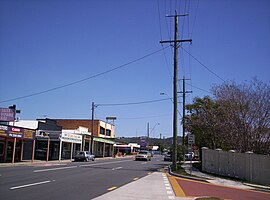Ashgrove, Queensland
|
Ashgrove Brisbane, Queensland |
|||||||||||||
|---|---|---|---|---|---|---|---|---|---|---|---|---|---|

Ashgrove, with Mount Coot-tha in the distance
|
|||||||||||||
| Population | 12,916 (2011 census) | ||||||||||||
| • Density | 2,306/km2 (5,970/sq mi) | ||||||||||||
| Postcode(s) | 4060 | ||||||||||||
| Area | 5.6 km2 (2.2 sq mi) | ||||||||||||
| Location | 4 km (2 mi) from Brisbane | ||||||||||||
| LGA(s) | City of Brisbane (Enoggera Ward,The Gap Ward) | ||||||||||||
| State electorate(s) | |||||||||||||
| Federal Division(s) | Brisbane | ||||||||||||
|
|||||||||||||
Ashgrove is an inner suburb in the City of Brisbane in Queensland, Australia. It is located approximately 4 kilometres (2.5 mi) north-west of the Brisbane CBD. Ashgrove is an upmarket, leafy residential suburb characterised by its hilly terrain and characteristic Ashgrovian houses built in the early 20th century. While many of the surrounding suburbs have seen an increase in the number of residential apartments built in the past decade, Ashgrove remains predominantly a suburb of detached single dwelling houses, with many old Queenslander homes in the area. It contains the localities of Dorrington and St Johns Wood.
The 2011 census recorded 12,916 residents in Ashgrove, of whom 50.1% were female and 49.9% were male. The median age of the population was 34; 3 years younger than the Australian median.
79.8% of people living in Ashgrove were born in Australia, compared to the national average of 69.8%. The other most common countries of birth were England (3.7%), New Zealand (2.7%), the United States (0.7%), Scotland (0.6%), and India (0.6%). 90.1% of people only spoke English at home, while the next most commonly spoken languages were Italian (0.9%), German (0.4%), French (0.4%), Hindi (0.4%), and Mandarin (0.4%).
Ashgrove's native name is 'Kallindarbin' and was originally inhabited by the indigenous 'Turrbal' or 'Duke of York clan'. The main thoroughfare, Waterworks Road, was built on a Turrbal pathway that led to Mount Coot-tha, a place of the 'Honey-Bee Dreaming' and to the Enoggera Reservoir. The first sales of freehold land commenced in 1856, and ceased in 1875 when all available land was sold. Soon after sale of land stopped, the first school (the Ashgrove State School) and post office was established.
The area remained primarily a farming district until the end of the 19th century, when growth accelerated with the sale of land which housed one of the first homesteads in the area, the 'Granite House' in the area still known as St Johns Wood. In 1920, the tram line was extended from Red Hill, Queensland to Ashgrove, along Waterworks Road, connecting the suburb with the rest of Brisbane. The tram line closed on Monday 5 August 1968.
...
Wikipedia
